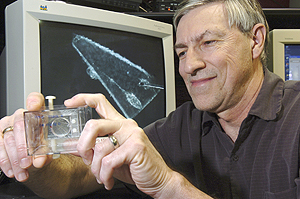University researchers first to examine Stardust mission’s comet samples
By Steve KoppesNews Office
 Stephen Sutton holds a case containing a sample of aerogel embedded with space dust collected by the National Aeronautics and Space Administration’s Stardust mission. The computer behind him shows a magnified view of a sample. Sutton is a Senior Scientist in Geophysical Sciences and Associate Director of the Consortium for Advanced Radiation Sources at Argonne National Laboratory. | |
Scientists at the University are among the first ever to analyze cometary dust delivered to Earth via spacecraft.
Extraterrestrial material routinely falls to Earth as meteorites, but never before NASA’s Stardust mission have scientists had access to verified samples of a comet. The leftover debris from the formation of the solar system 4.5 billion years ago, comets consist mostly of ice, dust and rock.
“We think comets make up a huge amount of stuff out in the solar system. We’d like to know the mineral composition of this big component of the solar system that we’ve never seen before for sure,” said Lawrence Grossman, Professor in Geophysical Sciences and the College. “Various particles have been measured that have been inferred to be from comets, but nobody’s sure. This would finally provide some ground truth.”
Grossman and Steven Simon, Senior Research Associate in Geophysical Sciences, are members of the Stardust PET (Preliminary Examination Team). So are Andrew Davis, Senior Scientist in the Enrico Fermi Institute, and his colleagues Michael Pellin and Michael Savina of the U.S. Department of Energy’s Argonne National Laboratory.
The role of PET is to describe the samples in a general way so other scientists can propose more detailed studies based on that information.
Davis also is a member of the Stardust Sample Allocation Committee, which will decide how to distribute the samples for additional research once the preliminary examination period ends in mid-July.
The Stardust mission launched in February 1999, carrying a set of instruments that included one provided by the University to monitor the impact of cometary dust. On Jan. 2, 2004, the spacecraft came within 150 miles of the comet and collected thousands of tiny dust particles streaming from its nucleus. The Stardust sample-return canister parachuted onto the desert salt flats of Utah in mid-January following a journey of nearly three billion miles.
During the 2004 cometary encounter, the University’s Dust Flux Monitor Instrument successfully determined the flow and mass of the particles streaming from the comet’s nucleus. Based on data collected by the instrument, the University’s Anthony Tuzzolino and Thanasis Economou, both Senior Scientists in the Enrico Fermi Institute, estimated that the spacecraft had collected at least 2,800 particles measuring 15 micrometers (one-third the size of a human hair) or larger during the flyby.
“Stardust was very successful beyond all expectation in all its phases,” said Economou, who was at the Johnson Space Center in Houston when the samples were delivered from Utah.
The comet dust is now available to compare with tiny particles that constantly rain down on Earth and which scientists suspect come from comets. NASA routinely collects these stratospheric dust particles with high-altitude aircraft and maintains a collection of them. Certain types of meteorites might also originate from comets, but without having cometary material to compare, “we don’t know,” Grossman said.
Grossman and Simon received several samples on Tuesday, Feb. 7. The samples partly consist of several thin slices of one dust grain mounted in epoxy and held on a round copper grid covered by a thin film. They also received a bullet-shaped epoxy plug holding the remainder of the grain.
Simon and Grossman are studying their slices with an electron microprobe and a SEM (scanning electron microscope). The microprobe is capable of revealing the chemical composition of microscopically small patches of material, while the SEM provides highly magnified images.
The Stardust cometary materials now join a collection of charged particles from the sun gathered by NASA’s Genesis mission and returned to Earth in 2004. Davis serves as chair of the Genesis Oversight Committee, which guides the curation and analysis of that mission’s extraterrestrial materials.
“Cosmochemistry is a very exciting field these days,” Davis said, referring to research on the origin of the chemical elements and the chemistry of extraterrestrial materials. “It’s an interesting time to get young people involved in the field.”
In 2004, along with colleagues at Argonne and the Field Museum, Davis organized the Chicago Center for Cosmochemistry to promote education and research in this field.
The Stardust spacecraft, meanwhile, may someday see further cometary action. “Stardust is still very healthy and has plenty of fuel left over,” said Economou. “After dropping the space return canister, the spacecraft was diverted from entering the Earth’s atmosphere and placed in an orbit around the sun that could bring it to the Temple 1 comet in February 2011.
This is the same comet that NASA’s Deep Impact mission collided with last year, making a large crater on its surface.”
![[Chronicle]](/images/sidebar_header_oct06.gif)